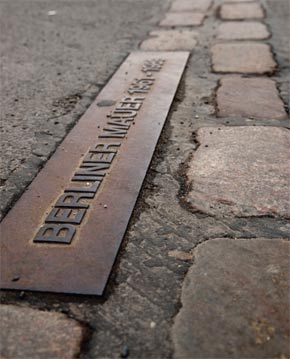 A little history reminder before I get into my story. After World War II, Germany was divided into two countries. For simplicity, they were generally referred to as East and West Germany. The West prospered under Allied control, while the East floundered under Soviet rule.
A little history reminder before I get into my story. After World War II, Germany was divided into two countries. For simplicity, they were generally referred to as East and West Germany. The West prospered under Allied control, while the East floundered under Soviet rule.
Migration from east to west reached two and a half million people and to stop this flow, a wall was built between the two countries, being completed in August 1961. The wall stood until November, 1989 when it was finally torn down.
A gate existed in this wall through which foot and vehicle traffic could pass under supervision of United States troops in the West, and German guards known as VOLPO in the East. At this site in October 1961 United States tanks lined up on the west side and Soviet tanks lined up on the east. The notoriety of this gate excited the imagination of generations in spy novels, as well as in reality. Its name conjured up intrigue, mystery, and suspense.
We first visited Checkpoint Charlie in early 1990. The wall was being demolished, kids were jumping over the huge blocks which were tumbling down, and tourists from all around the world were chipping pieces off the fallen wall for souvenirs. I must admit I joined the chippers.
Generally, the houses on the east side were quite close to the wall, but a patch – I would estimate it to be about fifty meters in width – lay to the west. Signs were posted by the East Germans that anyone traversing this field would be shot. The area was called “the killing field” for apparently if a person did manage to scale the wall, he/she was shot before reaching the other side.
We walked peacefully along the avenue known as Unter den Linden, through the famous Brandenburg Gate, and around the Reichstag. We were very fortunate as one of the days of our visit included the last “changing of the guard” of the Soviet troops in East Berlin.
At Checkpoint Charlie, I spoke in my childish German to a VOPO soldier. He told me that he would soon be relieved of his duties. As a hat collector I bought one of his fore-and-aft caps for five US dollars. It was his hope that he would be employed as a police officer in the United German Republic, but he was skeptical. He pointed out a number of spray-painted signs on and near the wall which read “Keine Stasi amnesty” which basically lobbied against amnesty for those soldiers who tried to stop migration into the west.
It is now twenty-two years later and once again we visited Berlin and found ourselves drawn to that intersection where Checkpoint Charlie existed. My, my – what a change!
In the center of the Friedrichstadt neighborhood a rough copy of the little hut used by the United States troops was located. On either side of the hut stood several “actors” in military uniforms waving the flags of the various countries they supposedly represented. All around it stood small kiosks offering fake military outfits, hunks of stones, various badges, and other miscellaneous souvenirs for sale. There were crowds snapping photos, buying junk, and doing what tourists are expected to do. It was a far cry from our previous visit.
To my mind, the major difference was the vast amount of buildings that had been erected. The “killing field” was now fully covered by brick multi-story buildings, going up some ten to twelve stories. The old Café Adler – which had been the place where agents, double agents, and triple agents waited and watched – was now a large restaurant serving beer and sausage at outdoor tables.
We enjoyed our visit to the new Berlin. We visited the standard historic places and added the recently-built ones, which included the eerie, claustrophobic, narrow walkways of the Holocaust Memorial. We marveled at the sections of the wall which have been left standing and into which has been incorporated an excellent history of this period.
But, I wish we had not seen Checkpoint Charlie. All the romance and intrigue that John Le Carré and other novelists had built is now gone. I much prefer my memory.
Leave a Reply